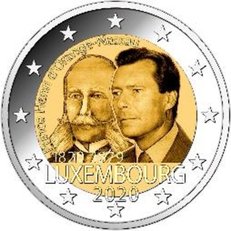New national side of euro coins intended for circulation
(2020/C 49/13)

National side of the new commemorative 2-euro coin intended for circulation and issued by Luxembourg
Euro coins intended for circulation have legal tender status throughout the euro area. For the purpose of informing the public and all parties who handle the coins, the Commission publishes a description of the designs of all new coins (1). In accordance with the Council conclusions of 10 February 2009 (2), euro-area Member States and countries that have concluded a monetary agreement with the European Union providing for the issuing of euro coins are allowed to issue commemorative euro coins intended for circulation, provided that certain conditions are met, particularly that only the 2-euro denomination is used. These coins have the same technical characteristics as other 2-euro coins, but their national face features a commemorative design that is highly symbolic in national or European terms.
Issuing country: Luxembourg
Subject of commemoration: The 200th anniversary of the birth of Prince Henri
Description of the design: The design shows on the right hand the effigy of His Royal Highness, the Grand Duke Henri, and on the left hand the effigy of Prince Henri. At the bottom is the name of the issuing country ‘LUXEMBOURG’ and the year-date ‘2020’. At the left, in semi-circle form, is the inscription ‘Prince Henri d’Orange-Nassau’ and underneath his effigy is the inscription ‘1820 – 1879’.
The coin’s outer ring depicts the 12 stars of the European flag.
Estimated number of coins to be issued: 500 000
Date of issue: January 2020
(1) See OJ C 373, 28.12.2001, p. 1 for the national faces of all the coins issued in 2002.
(2) See the conclusions of the Economic and Financial Affairs Council of 10 February 2009 and the Commission Recommendation of 19 December 2008 on common guidelines for the national sides and the issuance of euro coins intended for circulation (OJ L 9, 14.1.2009, p. 52).